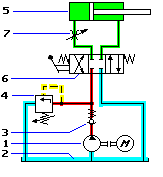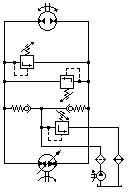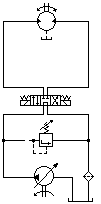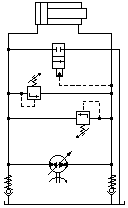The function and sequence of individual components within a system are represented on a circuit diagram by means of symbols.
All hydraulic devices and connections must be identifiable on the diagram.
The circuit diagram together with the function diagram are indispensable for assembling a system and for later fault finding.
Circuit Diagram
2 Tank
3 Non return valve
4 Pressure unloading valve
5 Cylinder
6 Directional valve
7 Flow control valve.
*Closed Circuit
In the closed circuit the operating fluid flowing back from the hydraulic motor flows directly
to the hydraulic pump.
In order to fill the circuit and to continuously compensate for inevitable leakage.
a feed pump is used with a delivery which must normally amount to approx. 15 % of the main flow.
Separately adjustable pressure limiting valves protect the system against overloading.
*Open Circuit.
With an open circuit the operating fluid flows from the tank to the hydraulic pump and is then transported to the
hydraulic motor.
From the hydraulic motor the medium flows unpressurized back to the tank, to be carried once more to the hydraulic pump.
The output direction of the hydraulic motor can be changed by means of a directional control valve.
A pressure limiting valve protects the system against overloading. The operating fluid is filtered on return.
Circuit, half open.
With a half-open circuit an insufficient volume flows in a certain flow direction from
the hydraulic motor back to the hydraulic pump.
The remaining amount is sucked out of the tank by means of an anti-cavitation valve.
The output device is normally a single rod cylinder, so that in the other flow direction
more operating fluid is directed to the hydraulic pump than it can take.
The difference is directed by means of a directional control valve to the tank.
Two pressure limiting valves protect the system against overloading.
Emergency actuation
In emergencies, e.g. during a power cut, (in addition to normal hand operation)
a working or closing stroke is carried out with the help of the energy in the accumulator.
In an emergency the valve reacts and the oil available in the accumulator is fed to the piston rod side of the
cylinder. This causes the piston to retract.
Meter-in
by means of 2-way flow control valve
Here flow control valve (1) is placed in the pressure line between hydraulic pump (4) and actuator (2). This type of
control is recommended for hydraulic systems in which the actuator acts as a positive resistance (opposing force)to the controlled flow.
Meter-out
control by means of 2-way flow control valve
Here, the flow control valve (1) is situated in the line between actuator (2) and the tank. This type of control is
recommended for hydraulic systems with negative (pulling) working loads, which tend to cause the cylinder piston
to move more quickly than the speed which corresponds to the delivery flow of the pump (4). The pressure unloading valve (3) must be set according to the highest actuator pressure.
Pressure loss test
With this test to ISO 3968 the pressure lost from filter housing equipment and filter elements is determined with relation to flow and viscosity.
By means of a variable pump installed in the test circuit the volume of flow may be changed as required.
Hydraulic oil of viscosity class ISO VG 32 is normally used as the test fluid.
Pressure loss through the housing and filter element is recorded. Measuring points p1 and p2 must be upstream of the test filter: 5 x DI
Downstream of the test filter: 10 x DI
on a straight piece of piping. (DI = internal diameter of the piping).
 Engineering for Hydraulics & Pneumatics (E.H.P.) in Egypt مصر
Engineering for Hydraulics & Pneumatics (E.H.P.) in Egypt مصر







